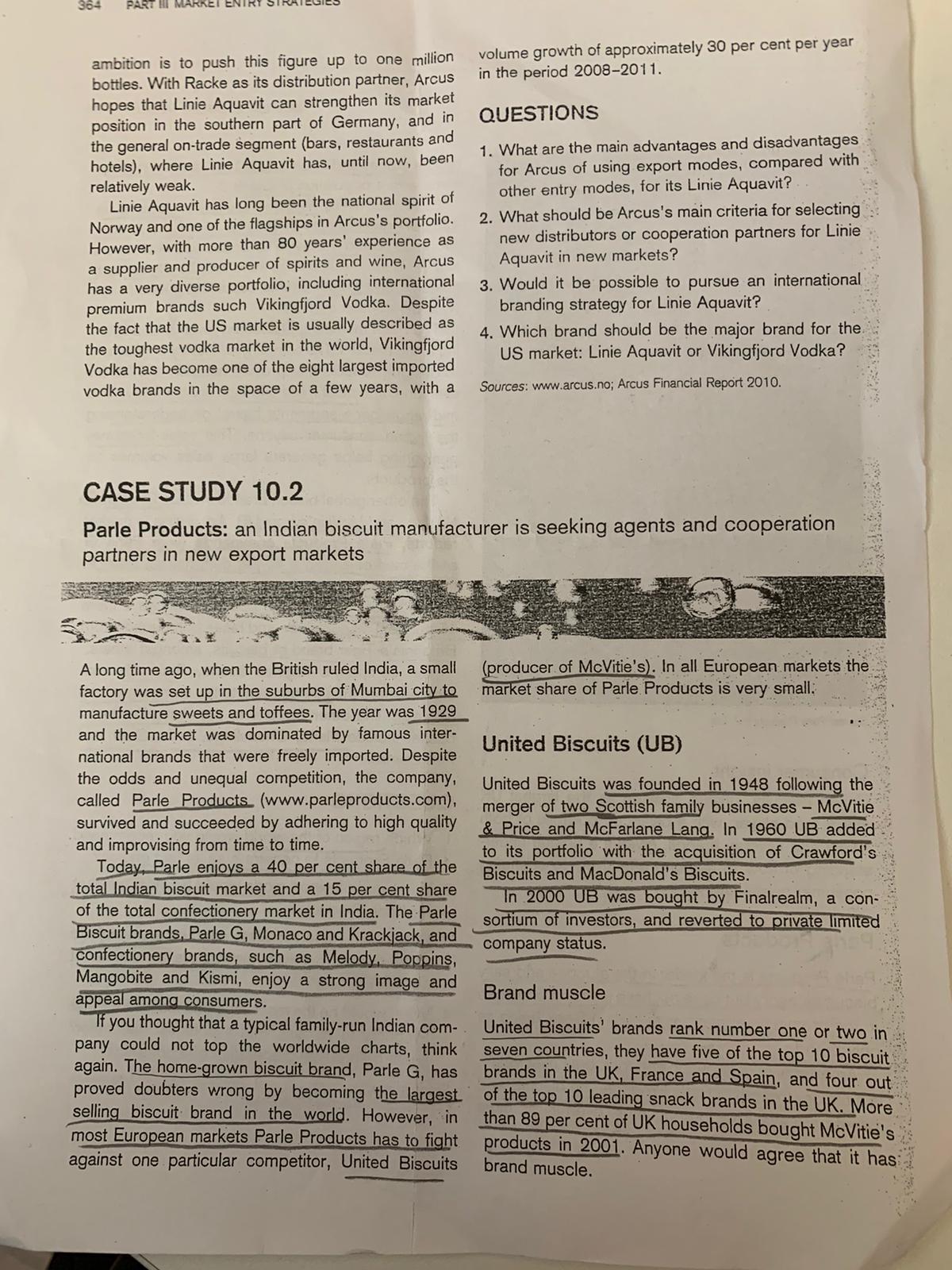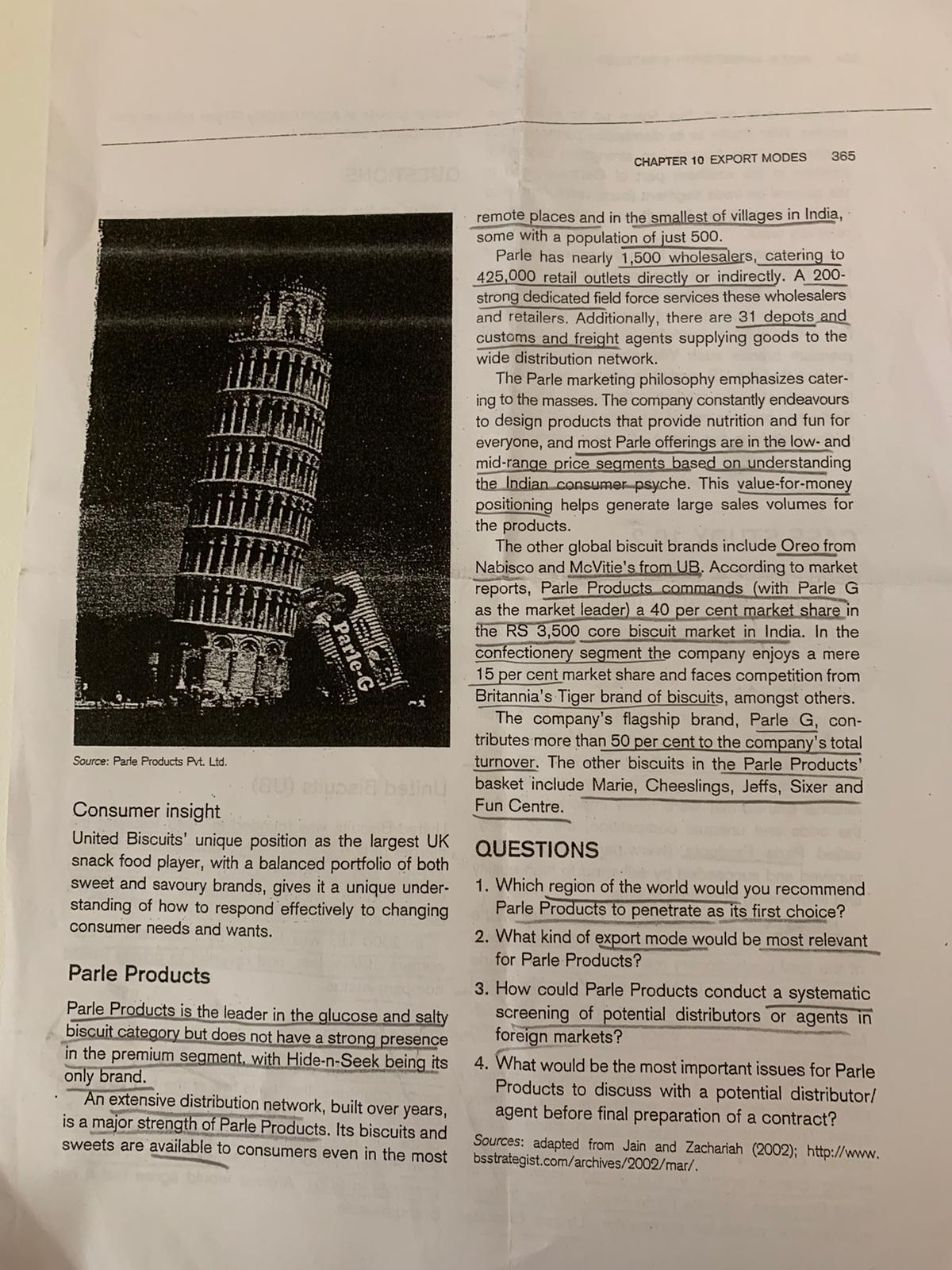Answer the qustions about Parle Products
ambition is to push this figure up to one million volume growth of approximately 30 per cent per year bottles. With Racke as its distribution partner, Arcus in the period 2008-2011. hopes that Linie Aquavit can strengthen its market position in the southern part of Germany, and in QUESTIONS the general on-trade segment (bars, restaurants and hotels), where Linie Aquavit has, until now, been 1. What are the main advantages and disadvantages relatively weak. for Arcus of using export modes, compared with Linie Aquavit has long been the national spirit of other entry modes, for its Linie Aquavit? Norway and one of the flagships in Arcus's portfolio. 2. What should be Arcus's main criteria for selecting However, with more than 80 years' experience as new distributors or cooperation partners for Linie a supplier and producer of spirits and wine, Arcus Aquavit in new markets? has a very diverse portfolio, including international premium brands such Vikingfjord Vodka. Despite 3. Would it be possible to pursue an international the fact that the US market is usually described as branding strategy for Linie Aquavit? the toughest vodka market in the world, Vikingfjord 4. Which brand should be the major brand for the Vodka has become one of the eight largest imported US market: Linie Aquavit or Vikingfjord Vodka? vodka brands in the space of a few years, with a Sources: www.arcus.no; Arcus Financial Report 2010. CASE STUDY 10.2 Parle Products: an Indian biscuit manufacturer is seeking agents and cooperation partners in new export markets A long time ago, when the British ruled India, a small (producer of Mcvitie's). In all European markets the factory was set up in the suburbs of Mumbai city to market share of Parle Products is very small. manufacture sweets and toffees. The year was 1929 and the market was dominated by famous inter- national brands that were freely imported. Despite United Biscuits (UB) the odds and unequal competition, the company, called Parle Products. (www.parleproducts.com), United Biscuits was founded in 1948 following the survived and succeeded by adhering to high quality merger of two Scottish family businesses - Mcvitie and improvising from time to time. & Price and Mcfarlane Lang, In 1960 UB added Today, Parle enjoys a 40 per cent share of the to its portfolio with the acquisition of Crawford's total Indian biscuit market and a 15 per cent share Biscuits and MacDonald's Biscuits. of the total confectionery market in India. The Parle In 2000 UB was bought by Finalrealm, a con- Biscuit brands, Parle G, Monaco and Krackjack, and sortium of investors, and reverted to private limited confectionery brands, such as Melody, Poppins, company status. Mangobite and Kismi, enjoy a strong image and appeal among consumers. Brand muscle If you thought that a typical family-run Indian com- pany could not top the worldwide charts, think United Biscuits' brands rank number one or two in again. The home-grown biscuit brand, Parle G, has seven countries, they have five of the top 10 biscuit proved doubters wrong by becoming the largest brands in the UK, France and Spain, and four out selling biscuit brand in the world. However, in of the top 10 leading snack brands in the UK. More most European markets Parle Products has to fight than 89 per cent of UK households bought Mcvitie's against one particular competitor, United Biscuits products in 2001. Anyone would agree that it has brand muscle.CHAPTER 10 EXPORT MODES 365 remote places and in the smallest of villages in India, some with a population of just 500. Parle has nearly 1,500 wholesalers, catering to 425,000 retail outlets directly or indirectly. A 200- strong dedicated field force services these wholesalers and retailers. Additionally, there are 31 depots and customs and freight agents supplying goods to the wide distribution network. The Parle marketing philosophy emphasizes cater- ing to the masses. The company constantly endeavours to design products that provide nutrition and fun for everyone, and most Parle offerings are in the low- and mid-range price segments based on understanding the Indian consumer psyche. This value-for-money positioning helps generate large sales volumes for the products. The other global biscuit brands include Oreo from Nabisco and Mcvitie's from UB. According to market reports, Parle Products commands (with Parle G as the market leader) a 40 per cent market share in the RS 3,500 core biscuit market in India. In the Parle-G confectionery segment the company enjoys a mere 15 per cent market share and faces competition from Britannia's Tiger brand of biscuits, amongst others. The company's flagship brand, Parle G, con- tributes more than 50 per cent to the company's total Source: Parle Products Pvt. Ltd. turnover. The other biscuits in the Parle Products' . (80) allupeid beijall basket include Marie, Cheeslings, Jeffs, Sixer and Consumer insight Fun Centre. United Biscuits' unique position as the largest UK snack food player, with a balanced portfolio of both QUESTIONS sweet and savoury brands, gives it a unique under- 1. Which region of the world would you recommend standing of how to respond effectively to changing Parle Products to penetrate as its first choice? consumer needs and wants. 2. What kind of export mode would be most relevant Parle Products for Parle Products? 3. How could Parle Products conduct a systematic Parle Products is the leader in the glucose and salty screening of potential distributors or agents in biscuit category but does not have a strong presence foreign markets? in the premium segment, with Hide-n-Seek being its only brand. 4. What would be the most important issues for Parle An extensive distribution network, built over years, Products to discuss with a potential distributor/ is a major strength of Parle Products. Its biscuits and agent before final preparation of a contract? sweets are available to consumers even in the most Sources: adapted from Jain and Zachariah (2002); http://www. bsstrategist.com/archives/2002/mar/








